
views
Boiling the Noodles

Fill a large pot about 2/3 full of water. Since the pasta needs lots of room to move around as it cooks, use a big pot. For example, if you'll be cooking a 1 pound (450 g) box of pasta, get out a pot that's at least 4 US quarts (3.8 L) in size. Then, pour in enough water to come 2/3 up the side of the pot. If you use a pot that's too small, your pasta is more likely to clump together as it cooks.

Cover the pot and bring the water to a boil. Set the pot of water on the stove and put a lid on it. Turn the burner to high and let the water come to a boil. You'll know the water is boiling when you see steam escaping from under the lid. Covering the pot with a lid will make the water boil faster.Tip Although you will be adding salt to the pasta water, don't add it before the water begins to boil. This can discolor your pot or corrode its surface.
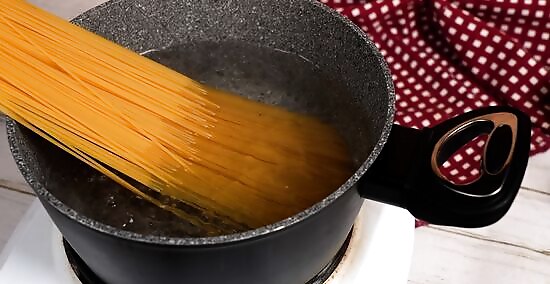
Add salt and 1 pound (450 g) of pasta to the boiling water. Once the water boils vigorously, remove the lid and add 1 tablespoon (17 g) of salt and 1 pound (450 g) of pasta. If you're cooking long noodles, such as spaghetti, that don't fit in the pot, wait about 30 seconds and then push them into the water using a spoon or pasta fork.Tip: You can easily halve or quarter the amount of pasta you wish to cook. If you cook 4 ounces (110 g) of pasta, use a 2 to 3 US quarts (1.9 to 2.8 L) sized pot. The salt will season the noodles as they cook, which will give you flavorful pasta. If you're unsure how many servings of pasta to cook, check the side of the box for recommended serving sizes.
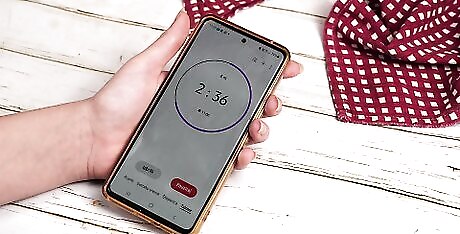
Set a timer for 3 to 8 minutes. Stir the noodles with a pasta fork to break the noodles up and leave the lid off the pot. Then, check the pasta package for a recommended cooking time and set a timer for the minimum time that's suggested. For example, if the box says to cook the noodles for 7 to 9 minutes, set a timer for 7 minutes. Thin pasta, such as angel hair, will cook faster than thick or long noodles, such as fettuccine or penne, which take closer to 8 or 9 minutes.
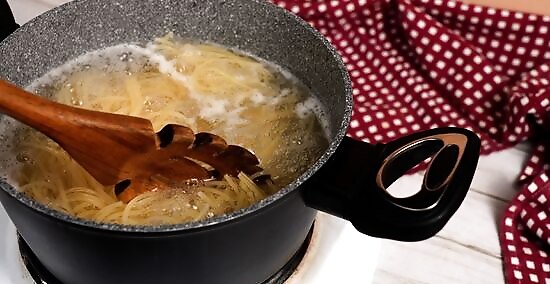
Stir the noodles occasionally as they boil. The water should continue to bubble as the pasta cooks. Stir it every few minutes to prevent the noodles from sticking together. If the water looks like it might boil over the sides of the pot, turn the burner down to medium-high.
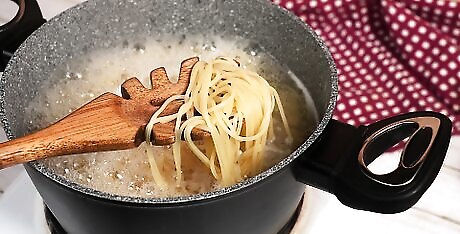
Bite into a noodle to see if it's cooked enough for you. Carefully scoop a noodle out of the water when the timer beeps and set it aside to cool a little. Bite into the noodle to tell if it's still hard in the center or if it's as soft as you like. Most people prefer to cook pasta until it's al dente, which means it's still a little firm in the center. If the pasta is still too hard for your liking, boil it for another minute before checking it again.
Draining the Pasta
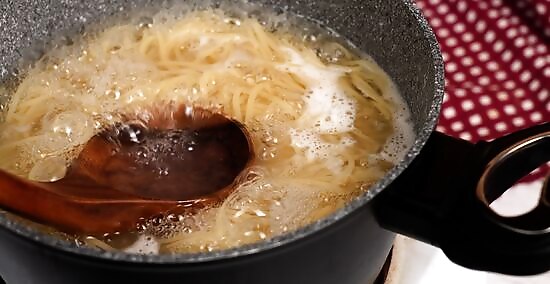
Scoop out about 1 cup (240 ml) of pasta water and set it aside. Carefully lower a mug into the pot and scoop some of the pasta water into it. Set the mug aside while you drain the pasta.Did You Know? You can use some of this pasta water to loosen the noodles after you toss them with sauce. You can also use a ladle to spoon 1 cup (240 ml) of the pasta water into a mug instead of lowering the mug into the water.

Set a colander in the sink and put on oven mitts. Place a large colander in the bottom of the sink and wear oven mitts to protect your hands from the boiling water. Even though the burner is turned off, the water can burn you if it splashes your skin.
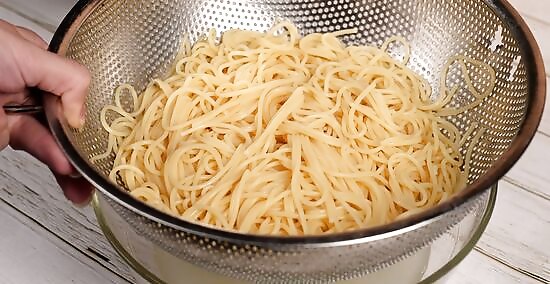
Pour the pasta into the colander and shake it. Slowly pour the pasta directly into the colander so the water drains into the sink. Hold the sides of the colander and shake it gently back and forth so excess water drips into the sink.
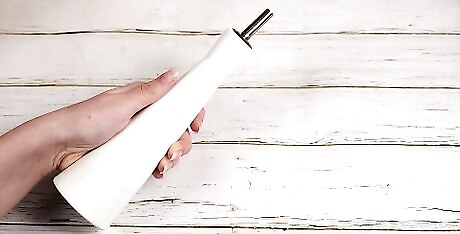
Avoid adding oil or running cold water over the pasta if you plan on using sauce. You may have heard people recommend tossing the cooked pasta with some olive oil or running cold water over the noodles to stop them from sticking together. Unfortunately, these can prevent sauce from sticking to your noodles.You should also avoid the practice of mixing freshly cooked pasta with butter or margarine. This prevents the pasta from mixing with the sauce.
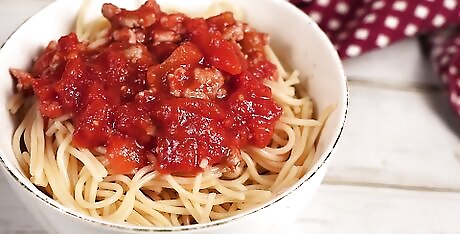
Put the pasta back into the pot and toss it with your choice of sauce. Take the colander of pasta out of the sink and transfer the noodles into the pot that you cooked them in. Then, pour in as much of your favorite sauce as you like and use tongs to combine it with the pasta. If the sauce is too thick, add some of the pasta water you reserved until the sauce loosens and coats the pasta.Did You Know? Italians recommend mixing the pasta in the same saucepan in which the sauce was prepared.
Pairing Pasta Types with Sauces
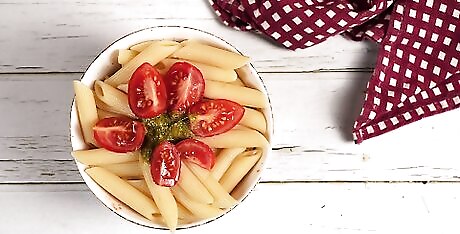
Toss short noodles with pesto or vegetables. Cook a pot of penne, fusilli, or farfalle pasta and stir in basil pesto. To add even more fresh flavor to the pasta, add chopped cherry tomatoes along with shredded bell peppers and zucchini. To serve this as cold pasta salad, refrigerate the pasta for at least 1 hour before you serve it so the flavors can develop. If you don't like the taste of traditional pesto, give sun-dried tomato pesto a chance. It has a more mellow flavor that works well with rich cheese, such as parmesan.
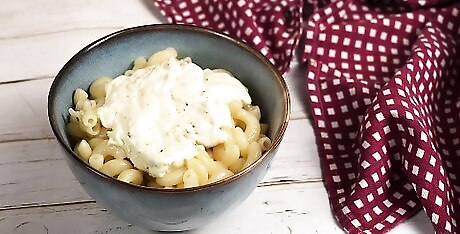
Mix cheese into macaroni or shells to make a creamy pasta. For the richest macaroni and cheese, stir together butter, flour, milk, and cheese to make sauce. Then, stir in cooked macaroni or shells and serve it or bake it to make it extra-bubbly.Variation: Cook extra-large shells and then stuff them with a mixture of ricotta and parmesan cheese. Pour marinara sauce over them and bake the pasta until the cheese bubbles. Play around with using different cheeses to find what you like. For example, use monterey jack, feta, mozzarella, or smoked gouda.
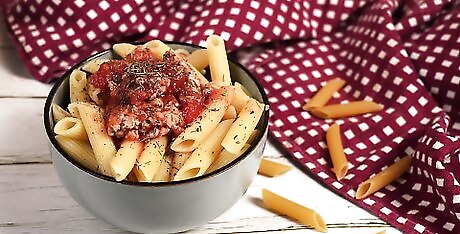
Serve meaty sauce over tubular or wide pasta. Boil a pot of pappardelle, penne, or bucatini and place it in a serving bowl. Spoon meat sauce, such as bolognese, over the noodles and stir them very gently so the meat sauce coats the pasta. Sprinkle a little parmesan over the top and serve the pasta while it's very hot. Remember to thin the pasta with a little reserved pasta water if the sauce is too thick.

Stir creamy alfredo sauce into long pasta. To coat the strands of long pasta, such as spaghetti, fettuccini, and angel hair, use tongs to mix them with rich alfredo sauce. Heat heavy cream with butter and garlic to make classic alfredo sauce and consider serving the pasta with grilled chicken or smoked salmon. For a slightly lighter sauce, melt butter with garlic and parsley. Then, toss the noodles in the simple sauce.













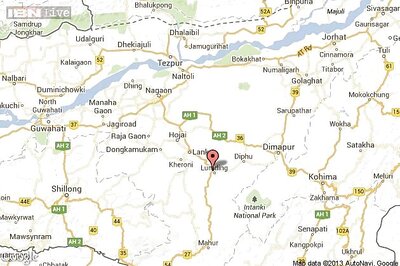

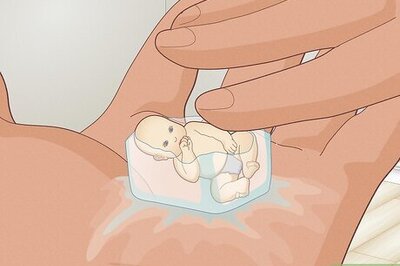

Comments
0 comment